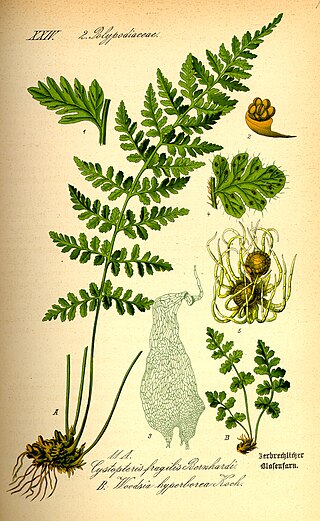
Erica arborea, the tree heath or tree heather, is a species of flowering plant (angiosperms) in the heather family Ericaceae, native to the Mediterranean Basin and Ethiopia, Kenya and Tanzania in East Africa. It is also cultivated as an ornamental.

Corn smut is a plant disease caused by the pathogenic fungus Mycosarcoma maydis. One of several cereal crop pathogens called smut, the fungus forms galls on all above-ground parts of corn species such as maize and teosinte. The infected corn is edible; in Mexico, it is considered a delicacy, called huitlacoche, often eaten as a filling in quesadillas and other tortilla-based dishes, as well as in soups.

A wildflower is a flower that grows in the wild, meaning it was not intentionally seeded or planted. The term implies that the plant is neither a hybrid nor a selected cultivar that is any different from the native plant, even if it is growing where it would not naturally be found. The term can refer to the whole plant, even when not in bloom, and not just the flower.

The Western corn rootworm, Diabrotica virgifera virgifera, is one of the most devastating corn rootworm species in North America, especially in the midwestern corn-growing areas such as Iowa. A related species, the Northern corn rootworm, D. barberi, co-inhabits in much of the range and is fairly similar in biology.

Justicia is a genus of flowering plants in the family Acanthaceae. It is the largest genus within the family, with over 900 accepted species. They are native to tropical to warm temperate regions of the Americas, India, and Africa. The genus serves as host to many butterfly species, such as Anartia fatima. Common names include water-willow and shrimp plant, the latter from the inflorescences, which resemble a shrimp in some species. The generic name honours Scottish horticulturist James Justice (1698–1763). They are closely related to Pachystachys.

Orobanchaceae, the broomrapes, is a family of mostly parasitic plants of the order Lamiales, with about 90 genera and more than 2000 species. Many of these genera were formerly included in the family Scrophulariaceae sensu lato. With its new circumscription, Orobanchaceae forms a distinct, monophyletic family. From a phylogenetic perspective, it is defined as the largest crown clade containing Orobanche major and relatives, but neither Paulownia tomentosa nor Phryma leptostachya nor Mazus japonicus.

Veratrum viride, known as Indian poke, corn-lily, Indian hellebore, false hellebore, green false hellebore, or giant false-helleborine, is a species of Veratrum native to eastern and western North America. It is extremely toxic, and is considered a pest plant by farmers with livestock. The species has acquired a large number of other common names within its native range, including American false hellebore, American white hellebore, bear corn, big hellebore, corn lily, devil's bite, duck retten, itchweed, poor Annie, blue hellebore and tickleweed.

Arctous alpina, the alpine bearberry, mountain bearberry or black bearberry, is a dwarf shrub in the heather family Ericaceae. The basionym of this species is Arbutus alpinaL..

Phytolacca americana, also known as American pokeweed, pokeweed, poke sallet, pokeberry, dragonberries, pigeonberry weed, and inkberry, is a poisonous, herbaceous perennial plant in the pokeweed family Phytolaccaceae. This pokeweed grows 1 to 3 metres. It has simple leaves on green to red or purplish stems and a large white taproot. The flowers are green to white, followed by berries which ripen through red to purple to almost black which are a food source for songbirds such as gray catbird, northern mockingbird, northern cardinal, and brown thrasher, as well as other birds and some small non-avian animals.

Veronica is the largest genus in the flowering plant family Plantaginaceae, with about 500 species. It was formerly classified in the family Scrophulariaceae. Common names include speedwell, bird's eye, and gypsyweed.
Squaw root is a common name which can refer to a number of different herbs native to North America:

Conopholis americana, the American cancer-root, bumeh or bear corn, is a perennial, non-photosynthesizing parasitic plant. It is from the family Orobanchaceae and more recently from the genus Conopholis but also listed as Orobanche, native but not endemic to North America. When blooming, it resembles a pine cone or cob of corn growing from the roots of mostly oak and beech trees.

Conopholis alpina, known as the alpine cancer-root, is an achlorophyllous, root parasitic plant (holoparasite).

Heuchera americana, or American alumroot, is a small evergreen perennial native to eastern and central North America while also ranging into Ontario, Canada. It is a part of the Saxifrage family.
Bear corn is a common name for several plants and may refer to:

Ionactis alpina is a species of flowering plant in the family Asteraceae known by the common name lava aster. It is native to western United States from California to Montana, where it grows in dry areas.

Woodsia alpina, commonly known as alpine woodsia, is a fern found in northern latitudes in North America and Eurasia. Also known as northern woodsia or alpine cliff fern, it is typically found in crevices, scree slopes and cliffs containing slate and calcareous rocks, especially limestone.
Squaw is an ethnic and sexual slur, historically used for Indigenous North American women.
















